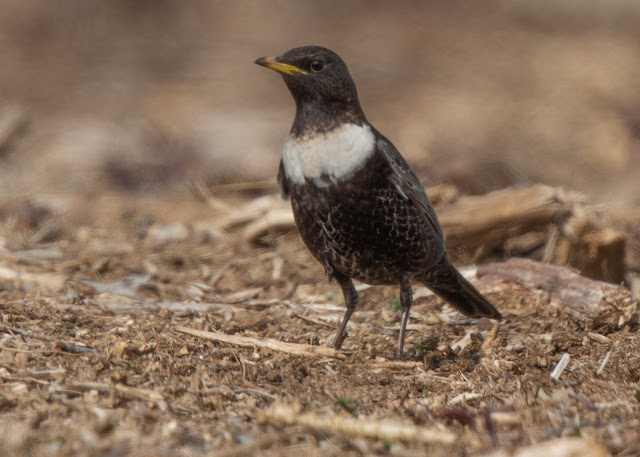There are two hilltop locations fairly local to me that are reliable for Ring Ouzels in the spring, namely Breedon Hill and Cleeve Common. Breedon Hill has the advantage that the summit is an hours strenuous walk from the nearest carpark and is hence normally peaceful. The disadvantage is that, at least in my experience, the Ring Ouzels tend to be somewhat below the summit on the escarpment where there are no rights of way or cover. On Cleeve Common, with a suitable amount of field craft, it is possible to get closer views but the big disadvantage is the continuous disturbance from joggers, dog walkers and cyclists.
These are passage migrants best seen at this time of the year as they head north from their African wintering grounds towards the mountainous terrain where they breed. It is sometimes called the Blackbird of the mountains but tends to be much more skittish than our common garden Blackbird, i.e. much more easily disturbed and flushed. The plumage of the male is entirely black except for a conspicuous white crescent on the breast, narrow greyish scaling on the upperparts and belly and pale edges to the wing feathers. The bill is yellow and the legs are greyish brown. The female resembles the male but is browner and with a duller breast band. There are 3 recognised subspecies. The Northern Ring Ouzel is the nominate subspecies normally seen here but sometimes the subspecies alpestris, which has a much more scaly appearance, is also seen on passage in the UK.
I’ve made a couple of visits to Cleeve Common in the past week. On the first visit I failed to find any but the second visit was much more successful. The technique I’ve developed over several years of visits to Cleeve is to start scoping the general area that they are found in from a hilltop bench which gives a good overview. On the second visit after 5 minutes or so I located 5 birds on a hilltop further back from where I have found them in previous years. There were 2 adult males, 2 adult females and what looked like a first winter male. Two other birders were watching them from a distance so I made my way to them and was just setting up to phone scope the birds when the inevitable happened – a dog walker went by and flushed the birds! I have had success in the past by finding a nice comfortable gorse bush (sic) at a sensible distance and hiding myself in it. So I moved a little closer and settled down in cover. After maybe 30 minutes I could heard the Ring Ouzels chattering to each other but no sooner had they landed when a distant jogger flushed them again. This small flock did seem much more skittish than birds at Cleeve in previous years. After another 30 minutes or so they returned again and I had some good scope views and managed a few photos. Yet again a distant jogger flushed them and as the sun was getting low, this seemed like my cue to leave
I had better views a couple of years back, again at the expense of a painful 3 hours in a gorse bush, so here are some photos from this occasion.













Great article. We've been searching for these for years. Going to try Cleeve this weekend! Fingers crossed!
ReplyDelete